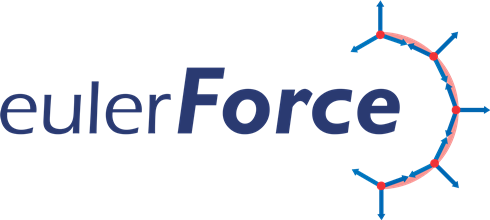This is the first automatic area-proportional Euler diagram drawing tool that uses ellipses. It generates an exact diagram for most of the cases,
and when it fails, the best diagram obtained through the hill climbing search is displayed, together with the inaccuracy values for each region.
Formal evaluation demonstrates that in contrast to various methods that use either circle or polygons, accurate and intuitive Venn diagrams can be
drawn for most random 3-set data using ellipses, which like circles are smooth and have good continuity. Other formal evaluation is being carried out
to investigate how well it can handle data sets with regions whose area has to be zero. More work is being carried out to improve the design and features of future releases.
Thus, any feedback is greatly appreciated. It is currently restricted to three curves, but later on, it will be extended to handle more curves.
Please acknowledge
eulerAPE
whenever used (see the Licensing Terms and PLoS ONE paper).



eulerAPE for real-world data: click on the image to view the diagram published in the journal article that discussed this real-world data
|
New improved version: eulerAPE v3
This page is dedicated to the latest version, eulerAPE v3.
Previous versions are available at:
v2,
v1.
|






|
|
|

The Pacific Northwest National Laboratory (PNNL) mentions eulerAPE on their Venn Diagram Plotter webpage, as an improved method for drawing area-proportional Venn diagrams with three curves.
eulerAPE featured in the New York Times magazine of April 15, 2013 to visualize the percentage of elderly with high blood pressure, heart disease, and/or Alzheimer's disease and other dementia. Currently, eulerAPE is being used for various application areas, such as health, medicine, bioinformatics, proteomics, genomics, biophysics, life sciences, brain and mind sciences, statistics, marketing, classification and database queries. eulerAPE v2 was selected for participation in the ACM Student Research Competition (SRC) at the 2012 Grace Hopper Celebration (poster to the left). |
|
Contents
Running on Mac OS X and getting the following message?








* the images below illustrate the interface when run on Windows and when the system locale is set to English
When eulerAPE starts, such a window opens:

To draw an area-proportional diagram, enter the area of every region or click on the random button to generate random region areas taken from a uniform distribution in the interval [1, 10000].

Alternatively, click on the load button and select a .els file ('eulerAPE region areas' file) or a .eld file ('eulerAPE diagram' file).

An eulerAPE region areas file with extension .els, such as this example (use a text editor to open or edit the file), defines the region areas to be loaded as follows:
6416.46 | 3097.123 | 7012.0 | 1742.5 | 9634.67 | 267.0 | 7163.0
An eulerAPE diagram file with extension .eld, such as this example (use a text editor to open or edit the file), defines the properties of the ellipses in the diagram as follows:
DIAGRAM ABSTRACTDESCRIPTION 0 a b c ab ac bc abc ELLIPSES - label | semi-major axis | semi-minor axis | centre - x | centre - y | rotation | a|52.0770762121543|57.12818461089164|2.891387939453125|0.003662109375|307.1356201171875| b|42.17083337286026|34.68449741129755|12.592274634627673|34.713064198564346|74.014892578125| c|48.55774377211602|59.11052662064727|27.344059440869614|-8.125|0.9979248046875|
To view the inital diagram that eulerAPE uses to start off the search process, click on the Starting Diagram button.

Alternatively or consequently, start the search process by clicking on the RUN button. Before doing so:
During the search, a timer (hours : mins : secs : msecs) is displayed in the bottom right corner of the window.
Once it stops running, a note saying Exact or Inexact is displayed just below the Starting Diagram button, to indicate whether an accurate or inaccurate diagram has been generated with respect to the required region areas. 
The accuracy of the generated diagram is measured by diagError, which is displayed below the table of the required and actual region areas.
diagError = max_{}{r \in R} \left | \frac{\text{required area of region }r}{\text{total area of the required diagram}} - \frac{\text{actual area of region }r}{\text{total area of the actual diagram}} \right |

To generate a diagram for a new set of region areas, click the clear all button and enter the areas manually, randomly or load them automatically from a file, as explained earlier.
Open the command prompt and change the current working directory to the directory where eulerAPE_3.0.0.jar is saved. Type in java -Duser.language=xx -Duser.region=XX -jar eulerAPE_3.0.0.jar where - xx is the ISO 639 alpha-2 (or ISO 639-1) language code (e.g., it for Italian; codes available here) - XX is the ISO 3166 alpha-2 (or ISO 3166-1) country code (e.g., IT for Italy; codes available here) followed by the required options
-i "C:\regionareas.els" -o "C:\eulerAPEv3_diagrams" -l yes -c yes --curves ellipses -s
Please cite eulerAPE as follows
|
For any questions, please contact Luana Micallef or Peter Rodgers (emails).
School of Computing
University of Kent
Canterbury, UK
 Copyright © 2011-2013, Luana Micallef and Peter Rodgers. All rights reserved.
Copyright © 2011-2013, Luana Micallef and Peter Rodgers. All rights reserved.
Last updated: July 18, 2014






